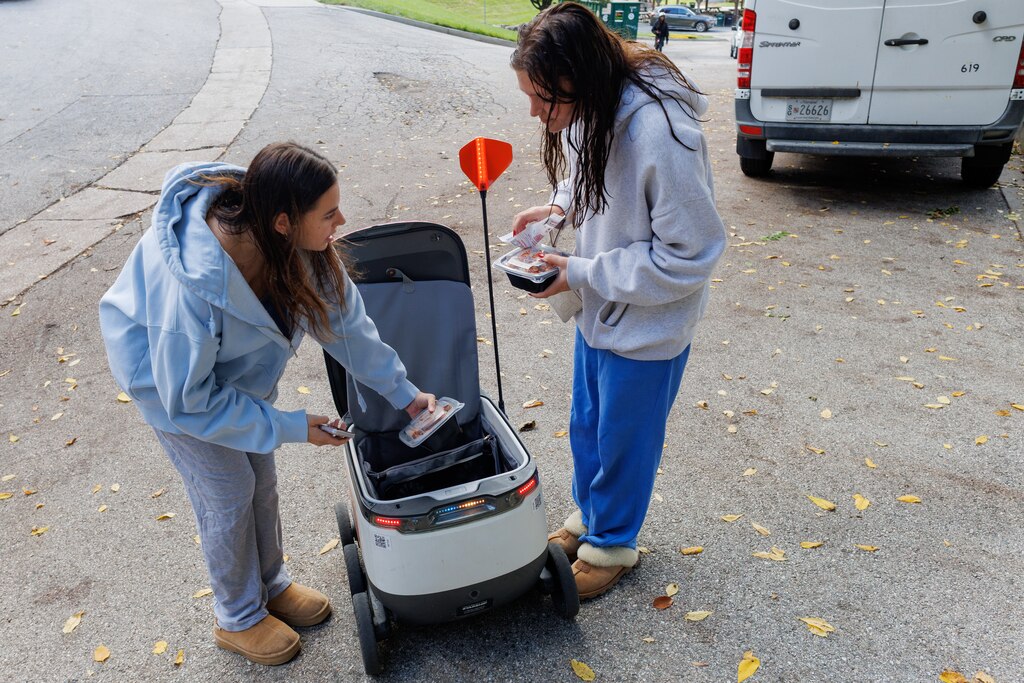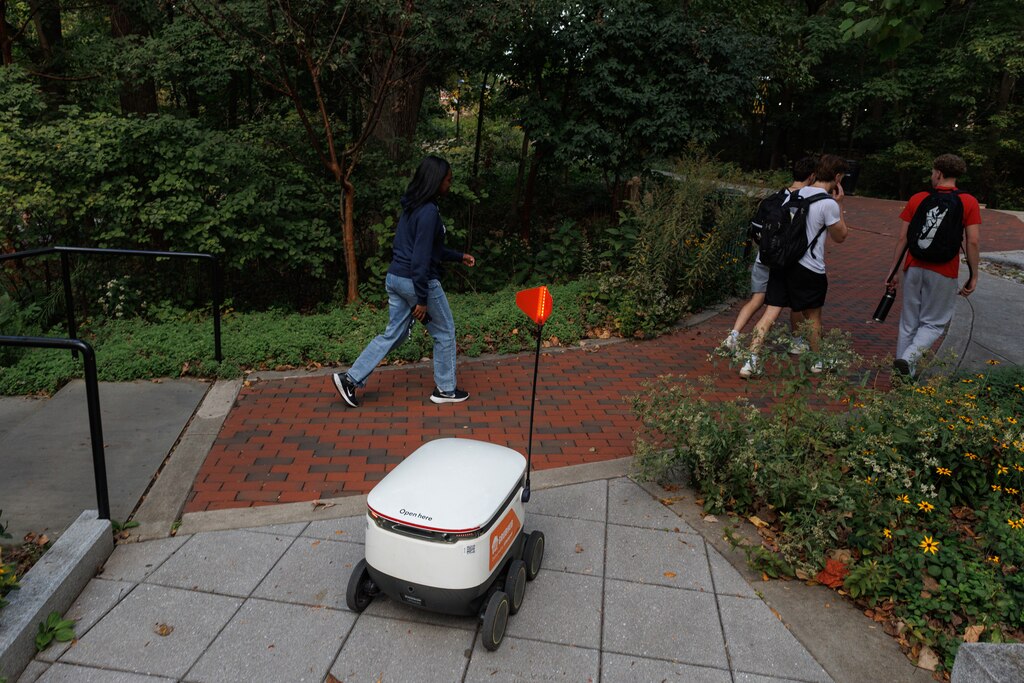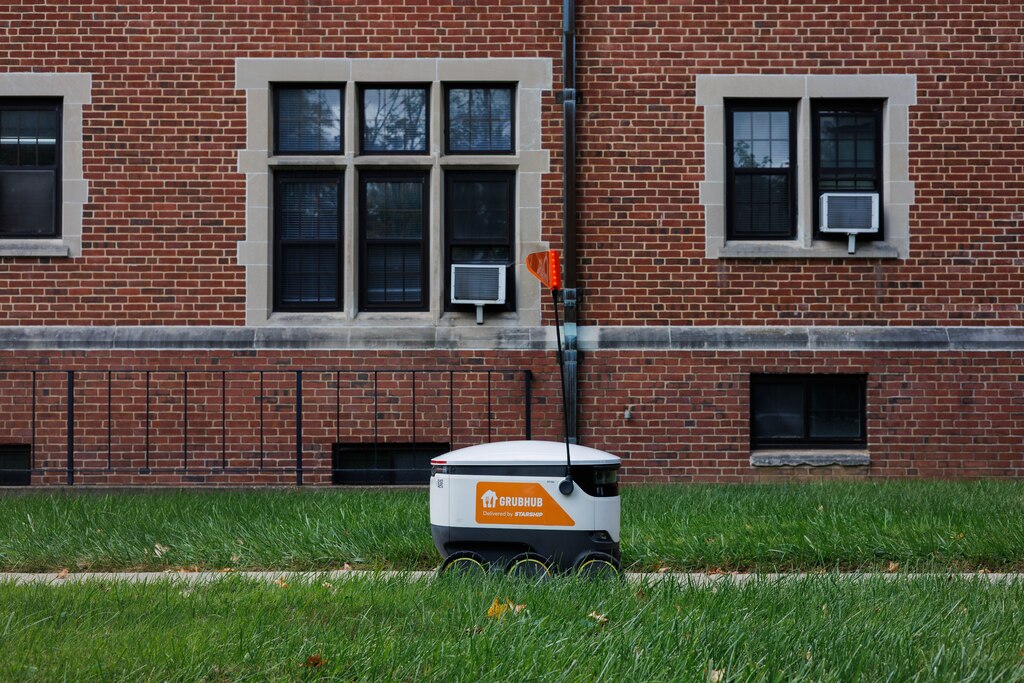It used to be that a college student in pursuit of a meal had to venture to a food court or dining hall, battling hills, bad weather, long lines and the urge to remain on the couch.
Not anymore. At least not at Towson University.
For months, the school has been deploying self-driving food-delivery robots, 27-inch-by-18-inch white boxes on wheels that ferry Grubhub orders from campus eateries to the sleep-deprived, the pajama-clad and the late-night revelers.
The fleet of 14 bots makes around 100 deliveries a day, said Richard Coburn, the mid-Atlantic district manager for Aramark Collegiate Hospitality, Towson’s food-service contractor.
One is unofficially named Snack Efron, a nod to former Disney Channel star Zac Efron — though there’s no way to tell him apart from the others, whose names are being workshopped.
The Baltimore County school, which has about 16,000 undergraduate students, is one of dozens of colleges and universities that has bots roaming its campus, transforming the way students get their pizza, burritos and wings.
“We’re meeting students where they are to offer convenience, flexibility and a modern way to enjoy their favorite retail meals on their own schedule,” Coburn said.


Towson rolled out its first three bots last spring through a partnership with the San Francisco-based robotics company Starship Technologies and food delivery platform Grubhub. Bowie State University is the only other Maryland campus using Starship robots.
Towson expanded its program this fall after seeing high demand during the pilot period. Another four bots could arrive in the coming weeks.
The food rovers weigh about 75 pounds and are studded with lights and sensors. A Starship technician spent roughly two days teaching the bots their routes by guiding them around campus with a handheld controller.
At first, the bots were objects of spectacle and curiosity, Coburn said. Many students snapped selfies and recorded TikTok videos with them. Others would jump in front of an unsuspecting bot to test its reaction.
Today, the bots draw the occasional amused look or offhand remark, but they’ve otherwise blended into the landscape of the university. Throngs of students pass them on the campus’ busy walkways without a second glance.
“People are unbothered by them at this point,” said Bethany Comegys, marketing manager for Aramark. “They’re a normal part of campus.”
To receive a robot delivery, a student places an order through Grubhub at a participating on-campus eatery, among them Panda Express, Chick-fil-A and The Den, a popular late-night offshoot of Denny’s.
Yes, the student pays a delivery fee. No, the bots don’t take tips.
A restaurant employee brings the order outside to an awaiting robot, loads it into the six-wheeled courier’s 12-inch-by-12-inch insulated compartment and secures the lid, which signals the bot to set off on its voyage.
The bot cruises along sidewalks and brick walkways at speeds of 3-5 mph and usually needs around 10 minutes to reach its destination, which could be a dorm, the library, the gym or an academic building. It moves like a skittish new driver, with abrupt stops, rapid accelerations, stilted turns and sudden jerks.


A number of bots zipped around campus during a recent Friday lunch rush. They rolled over sidewalk cracks, weaved around poles, climbed hills and dodged scooters, dogs and students buried in their phones, all without incident.
But the occasional mishap occurs, Coburn said. Robots have crashed into vehicles. One wandered from campus and ended up across Towsontown Boulevard.
About once a week, a bot tips over and needs help getting back on its wheels. Bots have also been known to get locked in staredowns as they pass each other on the sidewalks.
“It’s comical at times, but the robots do their best to stay on track,” Coburn said.
Early one Friday afternoon, a bot pulled up to a dorm on Cross Campus Drive, where freshman roommates Ali Beane and Mazzi Bouve were waiting on two orders of orange chicken and white rice from Panda Express. Bouve tapped a button in the Grubhub app that unlocked the robot’s hatch, and the two friends retrieved their deliveries inside.

Beane and Bouve said they used the robot service to save time and a trek across campus as they packed for a weekend trip. Their order arrived in under 20 minutes.
“They’re super cool and very convenient,” Bouve said of the robots.
“And so cute,” Beane added.
Bouve tapped another button on her phone to send the bot away.
“Thank you. Have a nice day,” it said as it rolled off.
Other deliveries that afternoon didn’t go as smoothly.

The pepperoni pizza Will Schoonmaker ordered after lacrosse practice took more than two hours to arrive. The iced mocha Kimora Miles bought for a study break toppled over, coating the bot’s interior in a wet, chocolatey mess.
Still, students said the bots offered many conveniences, making it easy to get a meal during long study sessions, illnesses or rainy weather.
“I usually use it at night because my classes are late,” Miles said. “Sometimes when I come home and I shower, I just want to stay in my bed.”
The bots stay on the move as long as the campus restaurants are open, typically until around 11 p.m.
Then they’re taken indoors, cleaned and left to rest overnight in their charging stations, until another long shift begins the next morning.




Comments
Welcome to The Banner's subscriber-only commenting community. Please review our community guidelines.